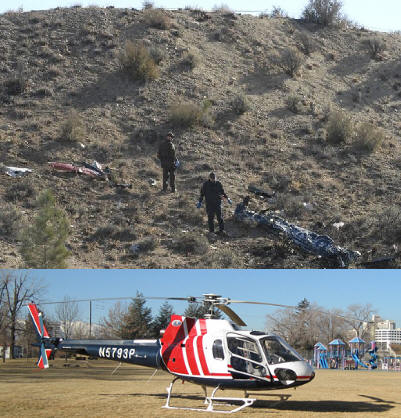
NEWSROOM
 |
NEWSROOM |
|
|
|
|
|||
|
Three
Perish In Mountain Lifeflight Helicopter Crash
By
|
||||
 |
November 15, 2009,
All three crew members on board were killed in the crash and subsequent
fire which destroyed the aircraft.
Crew members were: Pilot: James Bradshaw (age 39), Chief Flight Nurse:
Clinton Reger (age 40), and Chief Flight Paramedic: Christopher Ritz
(age 37). There were no survivors. There was not a patient on board.
Location of the incident was approximately 5 miles North of Hallelujah
Junction, approximately 15 miles North of Reno, Nevada.
|
|||
|
|
||||
|
He looked over the pilot's shoulder, and to the right, and
noted how glassy smooth the water was. He stated that it was like a
mirror and reflected the clouds and the sky perfectly, and was "kind of
mesmerizing and disorienting" to see clouds both above and below. Just
before they hit the water the pilot said on the intercom, "Boy, it's
disorienting when the lake is this smooth." The nurse looked out the
right side window at the distant shoreline and thought to himself that
the flight seemed very low. The helicopter then hit the water. The flight nurse and paramedic medical crew members stated
that there were no apparent mechanical malfunctions or failures with the
helicopter prior to the collision with the lake surface. Review of Federal Aviation Administration (FAA) medical
certification records disclosed that the pilot held a second-class
medical, which was issued April 24, 2001, with the limitation that the
pilot wear corrective lenses. The record sheet for the pilot's last FAA
medical examination noted that his distant and intermediate vision was
20/15 in each eye and his near vision was 20/100 in each eye. The operator reported the weather as 30 miles visibility;
temperature 46 degrees Fahrenheit; wind 110 degrees at 8 knots;
altimeter 30.02 inHg; and sky condition 18,000 overcast. The closest
aviation weather reporting station is the The wreckage was recovered from Examination of the extensively fragmented helicopter
disclosed that all control system torque and push/pull tubes, and their
associated rod end fittings, were accounted for. Scoring and other
rotational evidence was noted on all drive system components.
On March 25, 2002, the acting Lassen County Medical
Examiner performed an autopsy on the pilot. During the procedure samples
were obtained for toxicological analysis by the FAA Civil Aeromedical
Institute in A human performance study was accomplished by Safety Board
personnel. The report includes interviews with the surviving two crew
members, the operator, and family members, and is included in the docket
for this accident. As part of the study, the human performance investigators
reviewed the Safety Board accident records since May 1982, and found 33
accidents with glassy water cited as a factor. Nine of the accidents
involved helicopters, and all cited the pilot's failure to maintain
altitude as part of the causal chain. Commonly cited factors also
included glassy water conditions, which resulted in a lack of visual
cues for the correct perception of altitude. The
Eurocopter AS350 Ecureuil ("Squirrel") is a single-engined light
helicopter originally manufactured by A?rospatiale (now part of
Eurocopter Group). The AS350 is marketed in |
| ?AvStop Online Magazine Contact Us Return To News |